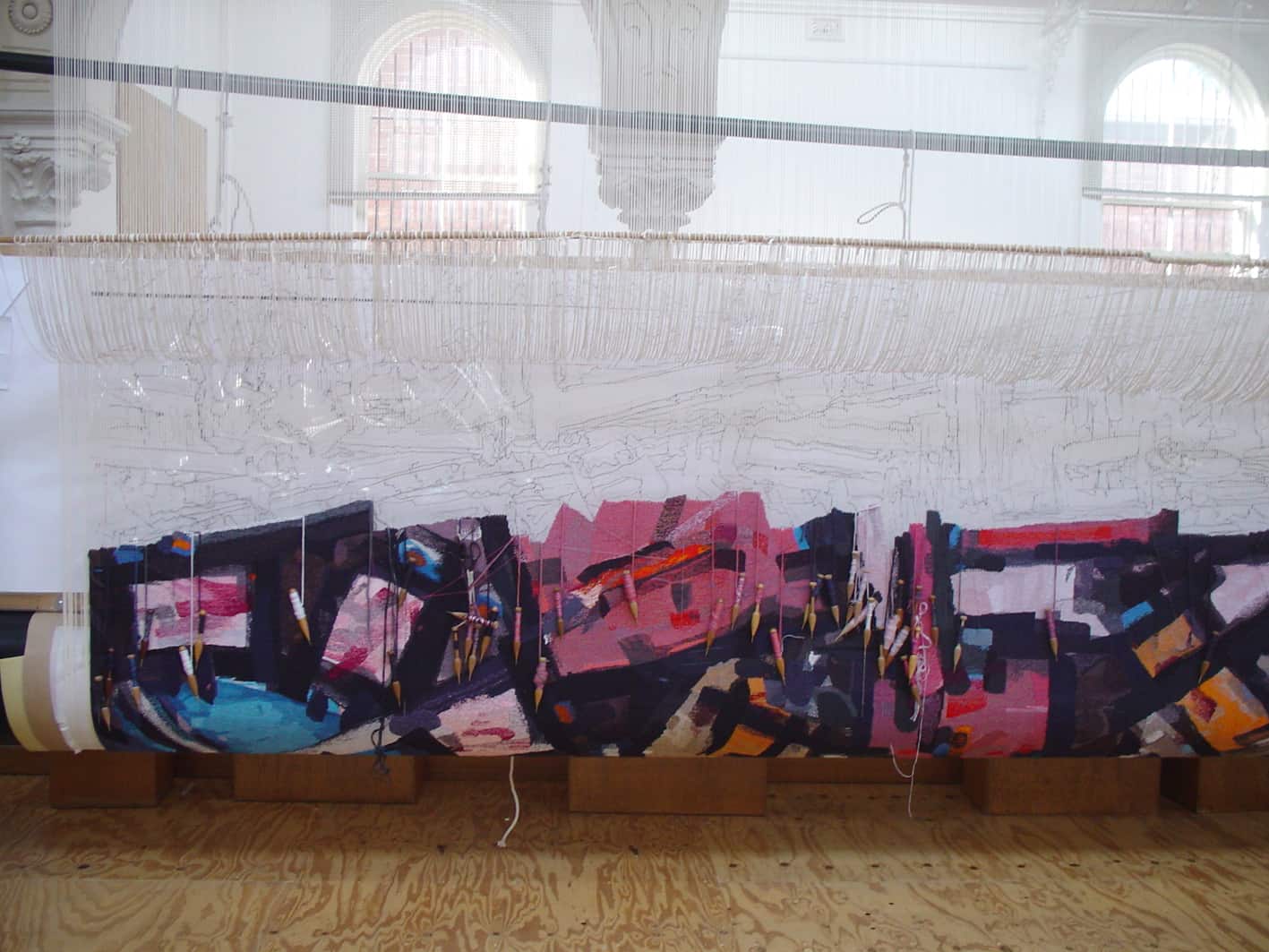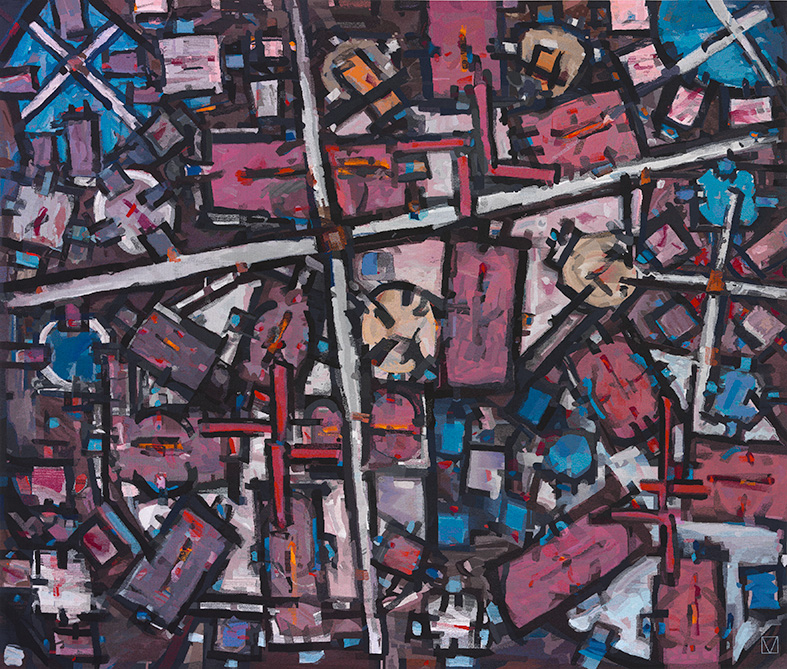



Abstract Sequence, woven in 2004, was created to be added to the suite of tapestries that Roger Kemp designed for the Great Hall in the National Gallery of Victoria.
Kemp was one of the earliest artists to work with the Tapestry Workshop. His visual language of symbolic forms made for a dynamic translation into tapestry. Kemp’s tapestry Images was commissioned in 1978 and acquired by the National Gallery of Victoria (NGV) in the same year. In 1984 he designed the tapestry Evolving forms, commissioned by the NGV to hang in the Great Hall.
Evolving forms became the first in a suite of three tapestries designed by Kemp for, and conceived as a response to, the Great Hall and its extraordinary faceted glass ceiling designed by Leonard French. Both artists' works harmonise: the broad steel trusses of the vaulted ceiling, with its bright glass, find an echo in the charcoal bands that delineate the abstract forms and jewel-like colours of ruby-red, turquoise, lilac and amethyst-pink in Kemp's tapestries.
The three tapestries demanded varying technical approaches. The first tapestry, Evolving forms, was soft in colour and approach. Weaver Cheryl Thornton notes, 'It was only when it was installed in the Great Hall that we discovered the high viewing distance made the tapestry read as a painting. For the next tapestry in the suite, Piano movement, we decided to accentuate the work's medium as a textile. We did this by exaggerating the stepping - the movement up and across the warp threads... which created the effect of a rougher, more jagged surface, giving the work more of a textile feel.”
The third tapestry, Organic form, was slightly more subdued and provided a visual balance to the contrast of the preceding two works. Kemp was actively involved in the translation of the first two works, but died in 1987 before Organic form was complete.
Abstract sequence continues the composition and themes of the previous works. By this stage the weavers not only had extensive knowledge and technical expertise to undertake the translation, but also a great awareness of Kemp's artistic sensibility. Thornton noted that when you worked closely with Kemp's mark-making, you can see that “These marks resolved the whole painting. Abstract sequence and Unity in space were a reminder of what a great artist Kemp had been: it was humbling to work with an artist of his calibre.”
Roger Kemp was a major contributor to the development of abstract painting in Australia. His work is housed in major collections in Australia and overseas.
Daisy Andrews comes from the remote Aboriginal community at Fitzroy Crossing in the Kimberley region of Western Australia. She was born at Cherrabun Station and belongs to the Walmajarri people. In 2004 the ATW translated her painting, Lumpu Lumpu country, into a tapestry.
The country of Lumpu Lumpu is Andrew’s ancestral terrain, but her family were already displaced when she was born. Stories about the land were narrated to Andrews by her parents and grandparents, but she only visited the area later in life. Her family, driven out by dispossession, were too traumatised to return. Andrew's paintings, drawings and prints of Lumpu Lumpu are made as memorials to her homeland.
The tapestry Lumpu Lumpu country captures the drama of the landscape with its cliffs and valleys, wildflowers and blazing red earth. The carpet of purple flowers finds a visual echo in the lavender coloured sky, and the whole image is suffused with sentiment. Andrew states “when I draw my picture I am seeing that good country in my head, looking at those sandhills, flowers, everything was very good. I think hard when I look at my country. I think how I have to paint it. I look hard, it makes me sad too, it is beautiful, good country, but it makes me sad to think about all of the old people who were living there.” [1]
This tapestry was the first tapestry produced for the Embassy Tapestry Collection and is currently on loan to The Australian Embassy in Tokyo. Lumpu Lumpu country, was commissioned by the Tapestry Foundation through the support of a number of private donors.
Since 1991 Andrews was an active member of the Mangkaja Arts Centre. Andrew’s work has been exhibited and housed widely in national and international collections.
The ATW was saddened to hear of Daisy’s passing in 2015 and hopes that her tapestry can exist as a legacy to her life story.
[1] Daisy Andrews, quoted in the Victorian Tapestry Workshop Newsletter, Vol 1, Issue 16, October 2004.
To celebrate the Melbourne Cricket Ground’s 150th anniversary, the Melbourne Cricket Club tapestry, designed by Robert Ingpen AM was woven by the ATW in 2002.
The monumental tapestry, measuring 2.00 x 7.00m, depicts key members of the Melbourne Cricket Club (MCC). Placed in chronological order, the figures depicted range from the MCC’s first president, Frederick Powlett, to champion Australian batsman-keeper Adam Gilchrist and Socceroo Kevin Muscat, who kicked Australia’s only goal in its 1-0 victory over Uruguay in a 2001 World Cup qualifying match.
Included are some of the greats of football and cricket, memorable sporting events such as the 1956 Olympic Games and Austral Wheel Races and other notable occasions like royal and papal tours, Billy Graham’s Crusade and the performance by the Three Tenors.
Ingpen painted the figures individually and then painted a broader yellow / orange canvas, allowing the weavers to position the figures as the tapestry developed on the loom.
The tapestry hangs proudly outside the Long Room at the MCG, where members and visitors can admire and identify those who have made a significant contribution to what the MCG is today.
Robert Ingpen is represented by Melaleuca Gallery in Victoria.
Reg Mombassa playfully captured Sydney suburbs in his design Bush suburbs, which was translated into a tapestry by the ATW in 2002.
Mombassa (AKA. Chris O’Doherty) is a painter, printmaker and designer well known to Australian audiences, not only through his design work for the lifestyle label Mambo but also as a former member of the band Mental As Anything. His imagery depicts suburban environments and the outback as well as iconic Australian views such as backyard barbeques. Bush suburbs is based on an amalgam of suburbs in Sydney, and the scene reflects a charmed world of perfect order, each element merrily – if not comically – in its place. The stereotyped suburban bungalows are adaptations of the houses Reg remembers as a child that his father built.
The design for this tapestry was selected because of the qualities it shares both with the great tapestries of the past, and the grand mural paintings of Stanley Spencer (who also drew inspiration from medieval tapestries). The flat picture plane, the firmly articulated graphic nature of the work, its decorative and narrative qualities, and its powerful representation of everyday life, have all made for a strong and moving tapestry on a mural scale.
Reg Mombassa is represented by Watters Gallery in Sydney.
Celebration, designed by David Larwill in 1999, was commissioned by the Government of Victoria and the Victorian Arts Centre Trust and gifted to Singapore’s Esplanade Performing Arts Centre (EPAC), to mark their official opening in 2001.
Larwill began painting in 1979. His joyful use of colour and form, and unique child-like freshness has seen him dubbed as one of the leading figurative expressionists in Australia.
EPAC desired a tapestry that would evoke a sense of celebrating the arts. The design needed to portray a powerful image, that would be eye-catching, taking into consideration that the tapestry would be viewed from a distance, hung in a large space approximately 3 metres from the floor. The resultant design sees the figures, that are synonymous with Larwill’s style, bursting forth from a vibrant red background.
The three weavers working on this project focused on maintaining the vibrancy and energy of Larwill’s original design. The tonal similarities of the design, provided through complex colour mixing, posed a challenge for the weavers. This difficulty was overcome by selecting more saturated shades of colour and playing cotton off against wool to create a surface texture. 13 strands of yarn were wound on each bobbin used.
In 1996 Wamungku- My Mother’s Country, designed by Ginger Riley Munduwalawala, was translated into tapestry. Munduwalawala (c1937-2002) was a member of the Mara Community from the Gulf country in Arnhem Land in the Northern Territory.
For many years Munduwalawala worked as a stockman on Nutwood Downs Station and, while travelling, met the well-known Indigenous artist Albert Namatjira, an encounter that was to influence his artistic development.
Munduwalawala’s large-scale tapestry Wamungku, My Mother’s Country was commissioned by the Department of Foreign Affairs and Trade in Canberra. The image is replete with references to Munduwalawala’s ancestral land on the Limmen Bight River in the Gulf country. The scene depicts a red sky and the symbolically important Four Archers, which represent hill formations in the Limmen Bight landscape, relating to stories of the creation myth. The image also includes animal totems such as kangaroos, snakes and sea eagles. One of the totems depicted repeatedly across the image –the white-breasted sea eagle – was the subject of an earlier, smaller tapestry woven by the Workshop. The sea eagle, known as Ngak Ngak in Munduwalawala’s native language, often appeared in his paintings as an emblem of vigilance, a totem keeping protective watch over his beloved homeland.
Taking six ATW weavers almost 2 years to complete, the Aotea Tapestry, designed by Robert Ellis is a significant contemporary tapestry and one of the principle artworks in the Aotea Centre’s collection.
Ellis is a prominent British-born New Zealand painter who is concerned with social, cultural and environmental themes.
Speaking of the tapestry, Ellis noted: “It was not my intention to be too specific, as many people will prefer to interpret it in their own way. There are many different levels of meaning, depending on the viewer’s outlook.”
Robert Ellis’ work is held in many major institutions. He is represented by Milford Galleries in Dunedin.
Woven in 1984, Roger Kemp’s Evolving Forms was designed to hang in the Great Hall of the National Gallery of Victoria (NGV).
Kemp was one of the earliest artists to work with the ATW. His visual language of symbolic forms made for a dynamic translation into tapestry. Kemp’s tapestry Images was commissioned in 1978 and acquired by the National Gallery of Victoria (NGV) in the same year.
Evolving forms became the first in a suite of three tapestries designed by Kemp for, and conceived as a response to, the Great Hall and its extraordinary faceted glass ceiling designed by Leonard French. Both artists' works harmonise: the broad steel trusses of the vaulted ceiling, with its bright glass, find an echo in the charcoal bands that delineate the abstract forms and jewel-like colours of ruby-red, turquoise, lilac and amethyst-pink in Kemp's tapestries.
Roger Kemp was a major contributor to the development of abstract painting in Australia. His work is housed in major collections in Australia and overseas.
Marie Cook designed Wattle in 1979, as a companion piece to Pink Heath, woven in the same year for the Sofitel Hotel in Melbourne.
As oppose to Pink Heath, which was woven on it's side, Wattle was woven horizontally. This allowed more weavers to work on the project and facilitated the decision to purchase a new 8m loom for the Workshop.
Wattle and Pink Heath have remained popular depictions of Australian flora and are still much loved by Melbournians.